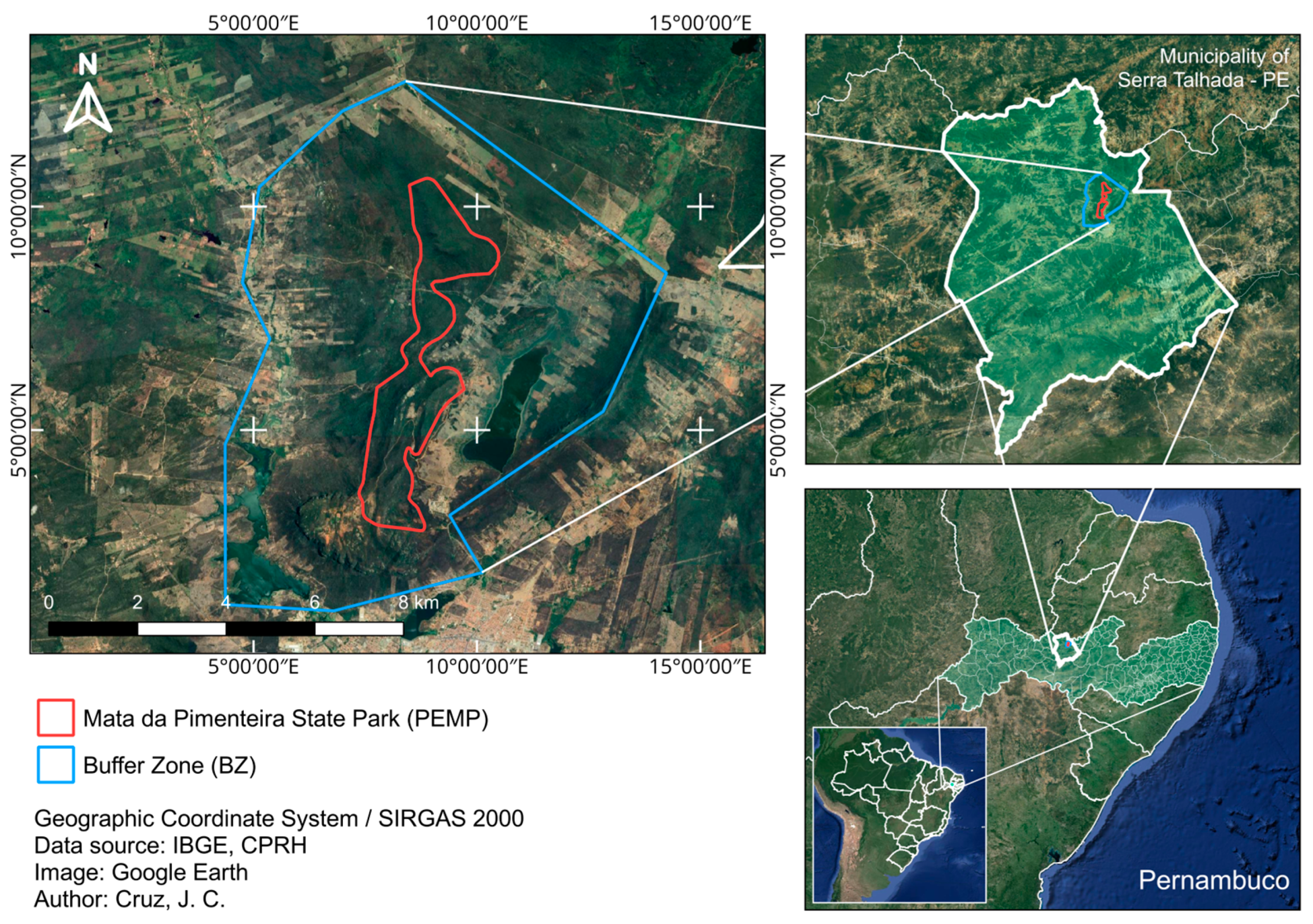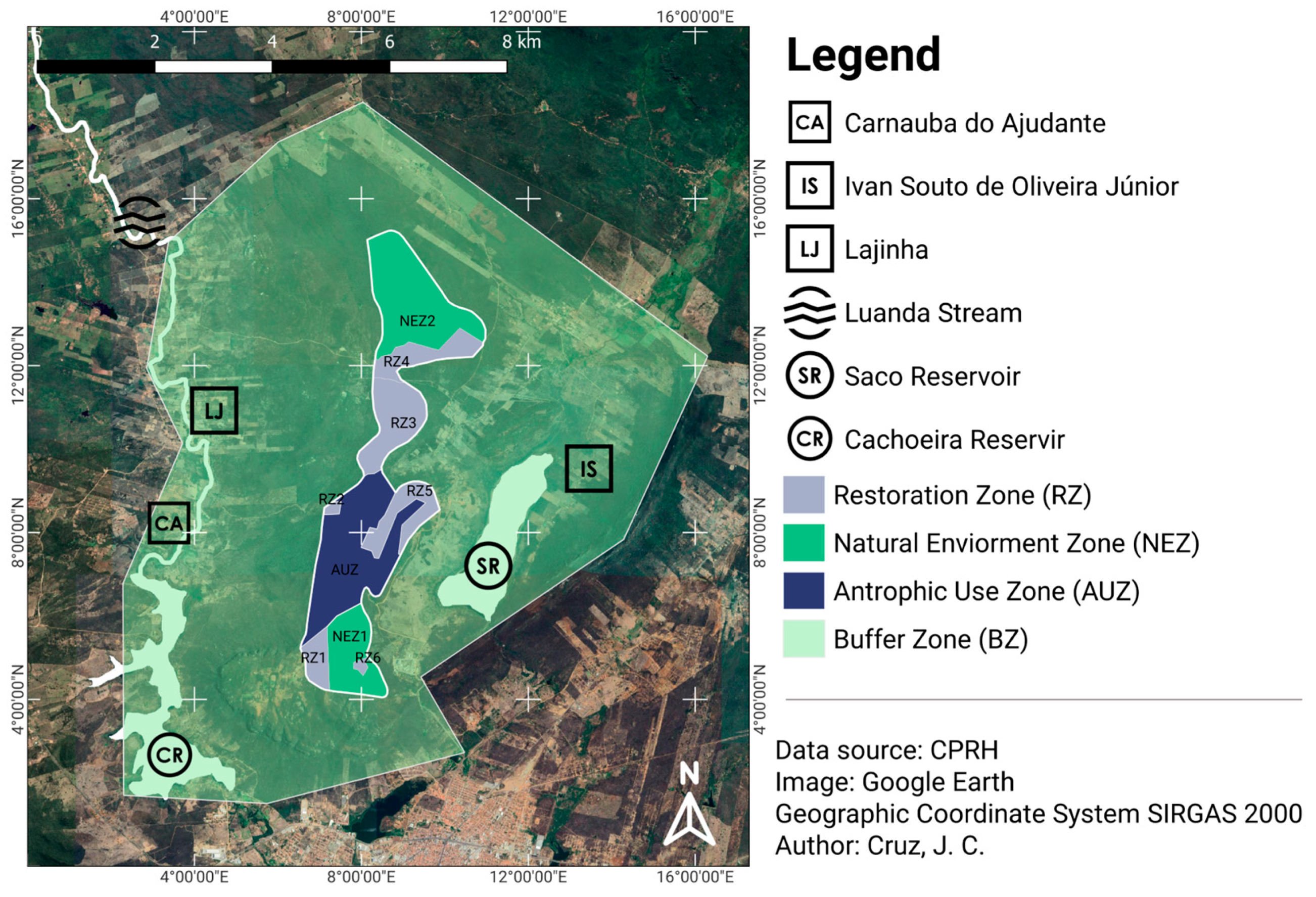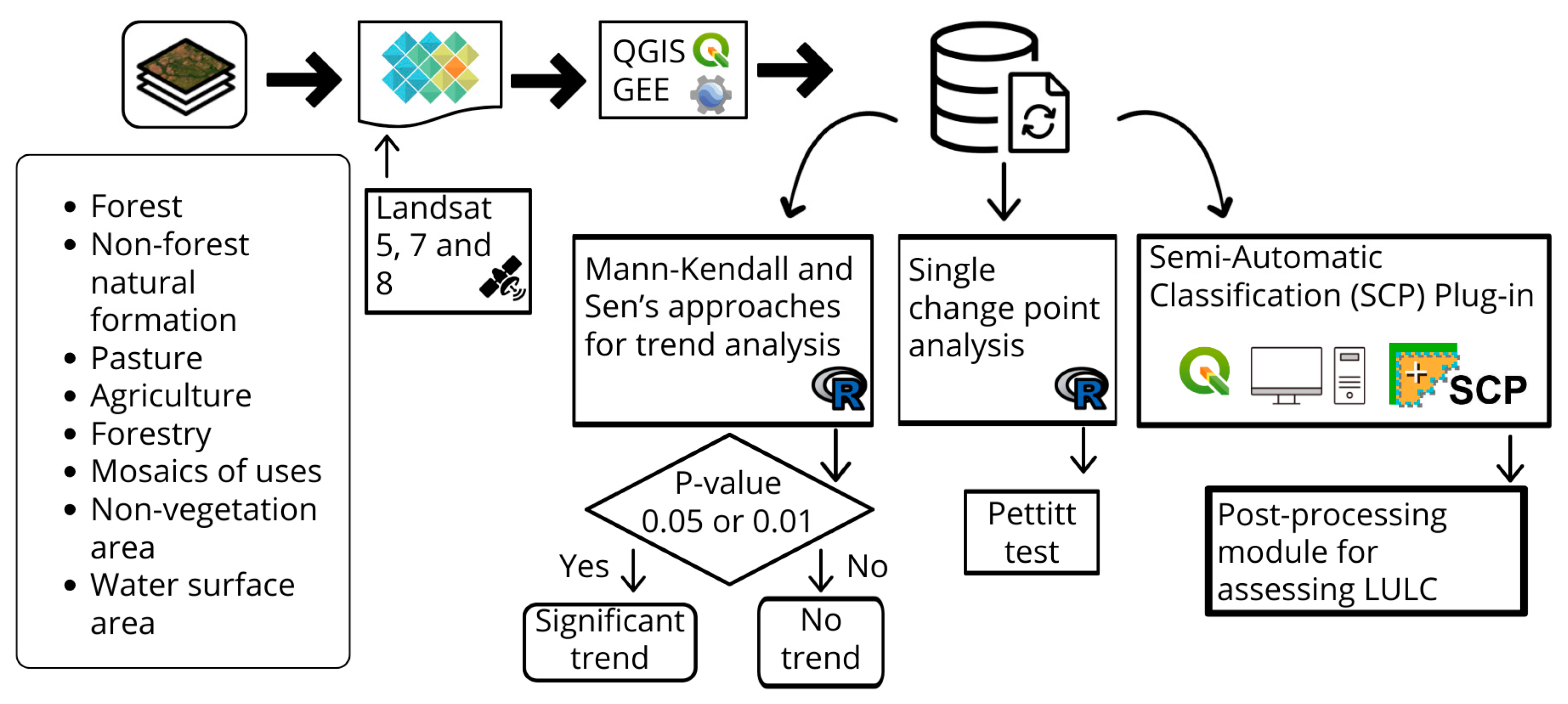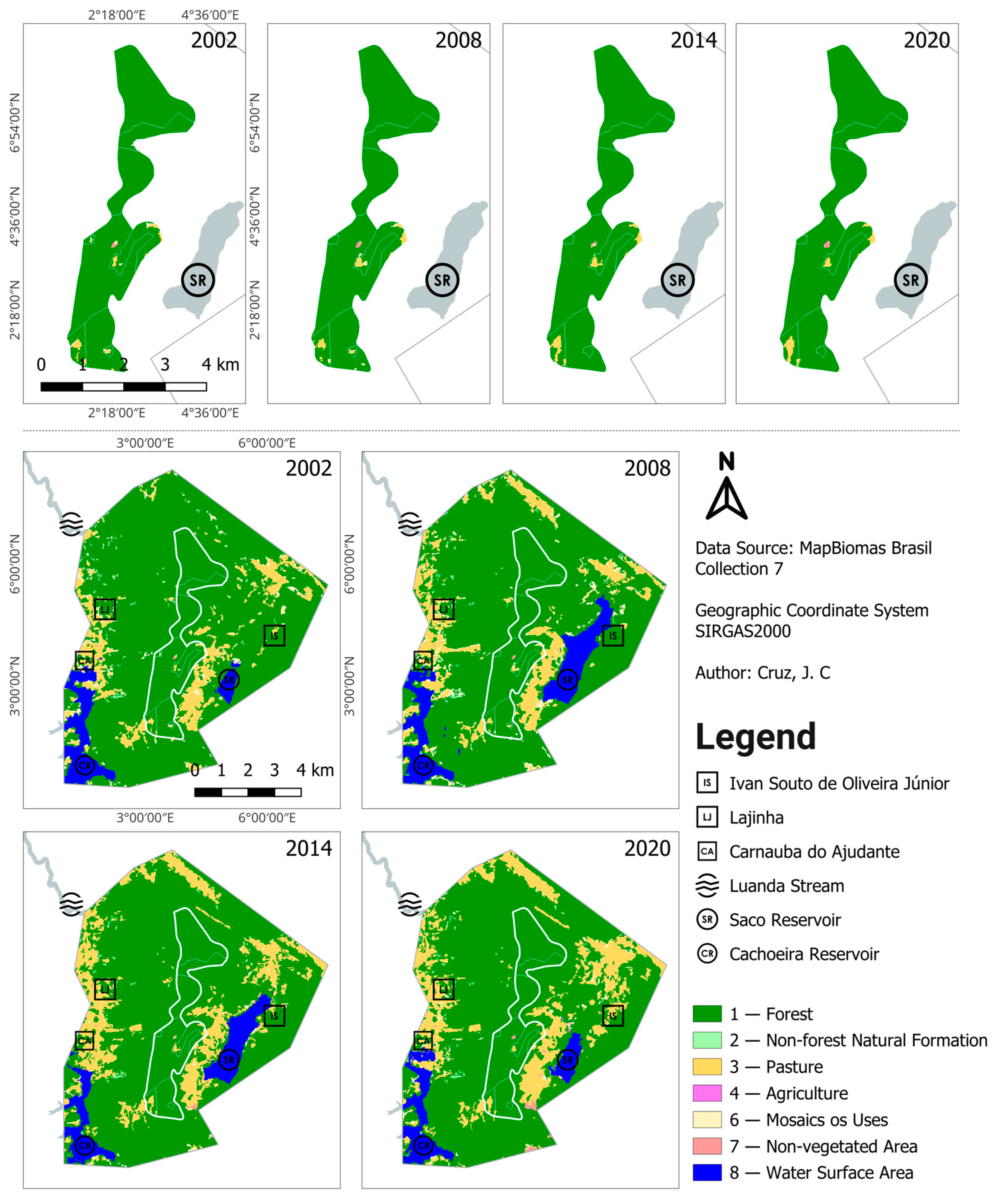Spatial–Temporal Dynamics of Land Use and Cover in Mata da Pimenteira State Park Based on MapBiomas Brasil Data: Perspectives and Social Impacts
Abstract
1. Introduction
2. Materials and Methods
2.1. Study Site
- Buffer zone (BZ)—This is an area surrounding a conservation unit where human activities are regulated by specific rules and restrictions to minimize negative impacts on the unit. Its purpose is to reduce external influences on the conservation area;
- Natural environment zone (NEZ)—This zone aims at fully protecting PEMP’s ecosystem, genetic resources and natural features while enabling scientific research activities. Human interference is minimized in it, and only the indirect use of its attributes is allowed. It is a refuge for rare, endemic, weak or endangered species;
- Anthropic use zone (AUZ)—These zones are designed for both conservation and human use purposes. They allow for people’s visitation and interaction with the natural environment. They accommodate buildings and the infrastructure necessary to manage the conservation unit and to implement activities outlined in the management plan;
- Restoration zone (RZ)—Publicly owned areas within PEMP that have undergone vegetation or soil changes require natural or induced recovery processes. The goal is to restore degraded ecosystems as closely as possible to their original condition. Once such a sector is restored, it is merged into another zone/sector.
2.2. Database
2.3. Land Use/Land Cover (LULC) Database
2.4. Trend Analysis
2.4.1. Mann–Kendall Test
2.4.2. Pettitt Test
3. Results and Discussion
3.1. Spatial Variability in Land Use and Land Cover (LULC)
3.2. Spatial Variability of Cover Changes
3.3. Time Trend Analysis
3.4. Analysis of Abrupt Changes
4. Conclusions
Author Contributions
Funding
Data Availability Statement
Conflicts of Interest
References
- United Nations. United Nations Convention to Combat Desertification in Countries Experiencing Serious Drought and/or Desertification, Particularly in Africa; Technical Report Document; United Nations Convention to Combat Desertification (Secretariat): New York, NY, USA, 1994. [Google Scholar]
- Palácio, H.A.Q.; Andrade, E.M.; Santos, J.C.N.; Neto, J.R.A.; Brasil, P.P. Emergy Evaluation of Semi-Arid Watersheds under Different Management Strategies. Trans. ASABE 2013, 56, 1357–1363. [Google Scholar] [CrossRef]
- Vorovencii, I. Applying the Change Vector Analysis Technique to Assess the Desertification Risk in the South-West of Romania in the Period 1984–2011. Environ. Monit. Assess. 2017, 189, 524. [Google Scholar] [CrossRef] [PubMed]
- Kumar, S.; Kumar, A. Hotspot and Trend Analysis of Forest Fires and Its Relation to Climatic in the Western Himalayas. Nat. Hazards 2022, 114, 3529–3544. [Google Scholar] [CrossRef] [PubMed]
- De Carvalho, A.A.; da Silva, M.J.G.; Batista, F.R.d.C.; Araújo, J.S.; Montenegro, A.A.d.A.; da Silva, T.G.F.; Almeida, T.A.B.; da Silva, M.V.; Dias, J.; Cavalcante, I.T.R.; et al. Spatio-Temporal Dynamics and Physico-Hydrological Trends in Rainfall, Runoff and Land Use in Paraíba Watershed. Geographies 2023, 3, 714–727. [Google Scholar] [CrossRef]
- Refati, D.C.; da Silva, J.L.B.; Macedo, R.S.; Lima, R.d.C.C.; da Silva, M.V.; Pandorfi, H.; Silva, P.C.; de Oliveira-Júnior, J.F. Influence of Drought and Anthropogenic Pressures on Land Use and Land Cover Change in the Brazilian Semiarid Region. J. South Am. Earth Sci. 2023, 126, 104362. [Google Scholar] [CrossRef]
- MapBiomas Project. Collection 8 of the Annual Land Cover and Land Use Maps of Brazil (1985–2022). 2024. Available online: https://brasil.mapbiomas.org/wp-content/uploads/sites/4/2023/10/FACT_MapBiomas_Florestas_23.10.2023_v5.pdf (accessed on 2 August 2024).
- Projeto MapBiomas Collection 7 of the Annual Series of Land Use and Land Cover Maps of Brazil. Available online: https://brasil.mapbiomas.org/wp-content/uploads/sites/4/2023/09/Fact_ing_versao-final.pdf (accessed on 9 December 2023).
- Bezerra, A.C.; da Silva, J.L.B.; Silva, D.A.D.O.; Batista, P.H.D.; Pinheiro, L.D.C.; Lopes, P.M.O.; Moura, G.B.A. Monitoramento Espaço-Temporal Da Detecção de Mudanças Em Vegetação de Caatinga Por Sensoriamento Remoto No Semiárido Brasileiro. Rev. Bras. De Geogr. Física 2020, 13, 286. [Google Scholar] [CrossRef]
- Nascimento, K.R.P.; Alves, E.R.; Alves, M.V.; Galvíncio, J.D. Impacto Da Precipitação e Do Uso e Ocupação Do Solo Na Cobertura Vegetal Na Caatinga. J. Environ. Anal. Prog. 2020, 5, 221–231. [Google Scholar] [CrossRef]
- Andrade, E.M.; Guerreiro, M.J.S.; Palácio, H.A.Q.; Campos, D.A. Ecohydrology in a Brazilian Tropical Dry Forest: Thinned Vegetation Impact on Hydrological Functions and Ecosystem Services. J. Hydrol. Reg. Stud. 2020, 27, 100649. [Google Scholar] [CrossRef]
- Jardim, A.M.d.R.F.; Júnior, G.D.N.A.; da Silva, M.V.; dos Santos, A.; da Silva, J.L.B.; Pandorfi, H.; de Oliveira-Júnior, J.F.; Teixeira, A.H.d.C.; Teodoro, P.E.; de Lima, J.L.M.P.; et al. Using Remote Sensing to Quantify the Joint Effects of Climate and Land Use/Land Cover Changes on the Caatinga Biome of Northeast Brazilian. Remote Sens. 2022, 14, 1911. [Google Scholar] [CrossRef]
- Medeiros, R.; Andrade, J.; Ramos, D.; Moura, M.; Pérez-Marin, A.M.; Dos Santos, C.A.C.; da Silva, B.B.; Cunha, J. Remote Sensing Phenology of the Brazilian Caatinga and Its Environmental Drivers. Remote Sens. 2022, 14, 2637. [Google Scholar] [CrossRef]
- Da Silva, J.L.B.; Moura, G.B.d.A.; da Silva, M.V.; de Oliveira-Júnior, J.F.; Jardim, A.M.d.R.F.; Refati, D.C.; Lima, R.d.C.C.; de Carvalho, A.A.; Ferreira, M.B.; de Brito, J.I.B.; et al. Environmental Degradation of Vegetation Cover and Water Bodies in the Semiarid Region of the Brazilian Northeast via Cloud Geoprocessing Techniques Applied to Orbital Data. J. South Am. Earth Sci. 2023, 121, 104164. [Google Scholar] [CrossRef]
- De Medeiros, M.B.; Fiedler, N.C. Incêndios florestais no parque nacional da Serra da Canastra: Desafios para a conservação da biodiversidade. Ciência Florest. 2004, 14, 157–168. [Google Scholar] [CrossRef]
- Nunes, G.A. Monitoramento Ambiental Por Meio Da Ciência Cidadã Em Cavernas de Unidades de Conservação Do Estado de São Paulo; Universidade de São Paulo: São Carlos, Brazil, 2021. [Google Scholar]
- Gorelick, N.; Hancher, M.; Dixon, M.; Ilyushchenko, S.; Thau, D.; Moore, R. Google Earth Engine: Planetary-Scale Geospatial Analysis for Everyone. Remote Sens. Environ. 2017, 202, 18–27. [Google Scholar] [CrossRef]
- Alencar, A.; Shimbo, J.Z.; Lenti, F.; Marques, C.B.; Zimbres, B.; Rosa, M.; Arruda, V.; Castro, I.; Ribeiro, J.P.F.M.; Varela, V.; et al. Mapping Three Decades of Changes in the Brazilian Savanna Native Vegetation Using Landsat Data Processed in the Google Earth Engine Platform. Remote Sens. 2020, 12, 924. [Google Scholar] [CrossRef]
- Souza, C.M.; Shimbo, J.Z.; Rosa, M.R.; Parente, L.L.; Alencar, A.; Rudorff, B.F.; Hasenack, H.; Matsumoto, M.; Ferreira, L.G.; E Souza-Filho, P.W.; et al. Reconstructing Three Decades of Land Use and Land Cover Changes in Brazilian Biomes with Landsat Archive and Earth Engine. Remote Sens 2020, 12, 2735. [Google Scholar] [CrossRef]
- Arruda, V.L.S.; Piontekowski, V.J.; Alencar, A.; Pereira, R.S.; Matricardi, E.A.T. An Alternative Approach for Mapping Burn Scars Using Landsat Imagery, Google Earth Engine, and Deep Learning in the Brazilian Savanna. Remote Sens. Appl.-Soc. Environ. 2021, 22, 2735. [Google Scholar] [CrossRef]
- Diniz, C.; Cortinhas, L.; Pinheiro, M.L.; Sadeck, L.; Filho, A.F.; Baumann, L.R.F.; Adami, M.; Souza-Filho, P.W.M. A Large-Scale Deep-Learning Approach for Multi-Temporal Aqua and Salt-Culture Mapping. Remote Sens. 2021, 13, 1415. [Google Scholar] [CrossRef]
- Rosa, M.R.; Brancalion, P.H.S.; Crouzeilles, R.; Tambosi, L.R.; Piffer, P.R.; Lenti, F.E.B.; Hirota, M.; Santiami, E.; Metzger, J.P. Hidden Destruction of Older Forests Threatens Brazil’s Atlantic Forest and Challenges Restoration Programs. Sci. Adv. 2021, 7, eabc4547. [Google Scholar] [CrossRef]
- Alvares, C.A.; Stape, J.L.; Sentelhas, P.C.; Leonardo, J.; Gonçalves, M.; Sparovek, G. Köppen’s Climate Classification Map for Brazil. Meteorol. Z. 2013, 22, 711–728. [Google Scholar] [CrossRef]
- Lins, F.A.C.; Da Silva, J.L.B.; Moura, G.B.D.A.; Ortiz, P.F.S.; Oliveira, J.D.A.; Alves, M.V.C. Quantile Technique to Precipitation, Rainfall Anomaly Index and Biophysical Parameters by Remote Sensing in Serra Talhada, Pernambuco. J. Hyperspectral Remote Sens. 2017, 7, 334–344. [Google Scholar] [CrossRef]
- Da Costa, S.A.T.; Bezerra, A.C.; Araújo, A.M.Q.d.A.; Silva, M.F.d.S.; da Neto, J.F.; Alves, R.M.; Souza, L.S.B. de Dinâmica Espaço-Temporal Das Anomalias de Precipitação Em Uma Região Semiárida, Nordeste Do Brasil. Rev. De Gestão De Água Da América Lat. 2021, 18, 1–15. [Google Scholar] [CrossRef]
- Fonseca, R.C.; Tavares, J.R., Jr.; Candeias, A.L.B. Programação Python e Índices Físicos Na Detecção de Bordas Na Unidade de Conservação Parque Estadual Mata Da Pimenteira (Pernambuco). Rev. Bras. De Sensoriamento Remoto 2020, 1, 42–57. [Google Scholar]
- Sousa, J.S.; Santos, E.M. dos Dinâmica Da Mudança Do Uso e Cobertura Da Terra Em Uma Paisagem Da Caatinga Protegida e Sua Zona de Amortecimento. Rev. Ibero-Am. De Ciências Ambient. 2020, 11, 219–234. [Google Scholar] [CrossRef]
- PERNAMBUCO Parque Estadual Mata Da Pimenteira: Plano de Manejo. Secretaria de Meio Ambiente e Sustentabilidade, Agência Estadual de Meio Ambiente 2013. Available online: https://www2.cprh.pe.gov.br/wp-content/uploads/2021/01/PE-Mata-da-Pimenteira-22-11-2013.pdf (accessed on 1 December 2023).
- Congedo, L. Semi-Automatic Classification Plugin Documentation; Release 8.1.3.1; GitHub: San Francisco, CA, USA, 2024. [Google Scholar]
- Iban, M.C.; Sahin, E. Monitoring Land Use and Land Cover Change near a Nuclear Power Plant Construction Site: Akkuyu Case, Turkey. Environ. Monit. Assess. 2022, 194, 1–19. [Google Scholar] [CrossRef]
- Gonçalves, V.; Ribeiro, E.A.W. Obtenção de Série Histórica Da Evolução Da Classe Floresta Plantada a Partir Dos Dados de Uso e Cobertura Do Solo Da Coleção 5 Do Projeto MapBiomas. Metodol. E Aprendizado 2021, 4, 99–105. [Google Scholar] [CrossRef]
- Li, T.; Li, M.; Ren, F.; Tian, L. Estimation and Spatio-Temporal Change Analysis of NPP in Subtropical Forests: A Case Study of Shaoguan, Guangdong, China. Remote Sens. 2022, 14, 2541. [Google Scholar] [CrossRef]
- Frimpong, B.F.; Koranteng, A.; Molkenthin, F. Analysis of Temperature Variability Utilising Mann–Kendall and Sen’s Slope Estimator Tests in the Accra and Kumasi Metropolises in Ghana. Environ. Syst. Res. 2022, 11, 1–13. [Google Scholar] [CrossRef]
- Mann, H.B. Non-Parametric Test against Trend. Econometrica 1945, 13, 245–259. [Google Scholar] [CrossRef]
- Kendall, M.G. Rank Correlation Methods; Charles Griffin: London, UK, 1975. [Google Scholar]
- Sneyers, R. On the Statistical Analysis of Series of Observations; Organisation Meteorologique Mondial—Note Technique; World Meteorological Organization: Geneva, Switzerland, 1975; 192p. [Google Scholar]
- Hamed, K.H.; Rao, A.R. A Modified Mann-Kendall Trend Test for Autocorrelated Data. J. Hydrol. 1998, 204, 182–196. [Google Scholar] [CrossRef]
- Randles, J. Introduction to Environmental Data Analysis and Modeling; Springer: New York, NY, USA, 2015. [Google Scholar]
- Theil, H.A. A Rank-Invariant Method of Linear and Polynomial Analysis, Part 3. Proc. Koninalijke Ned. Akad. Van Weinenschatpen A 1950, 53, 1397–1412. [Google Scholar]
- Sen, P.K. Estimates of the Regression Coefficient Based on Kendall’s Tau. J. Am. Stat. Assoc. 1968, 63, 1379–1389. [Google Scholar] [CrossRef]
- Campos, J.D.O.; Marinho, H.; Chaves, L. Tendências e Variabilidades Nas Séries Históricas de Precipitação Mensal e Anual No Bioma Cerrado No Período 1977–2010. Rev. Bras. De Meteorol. 2020, 35, 157–169. [Google Scholar] [CrossRef]
- Pettitt, A.N. A Non-Parametric Approach to the Change-Point Problem. J. R. Stat. Soc. Ser. C Appl. Stat. 1979, 28, 126–135. [Google Scholar] [CrossRef]
- Hajani, E.; Rahman, A. Characterizing Changes in Rainfall: A Case Study for New South Wales, Australia. Int. J. Climatol. 2018, 38, 1452–1462. [Google Scholar] [CrossRef]
- Dos Santos Clemente, S.; De Oliveira Júnior, J.F.; Passos Louzada, M.A. Focos de Calor Na Mata Atlântica Do Estado Do Rio de Janeiro. Rev. Bras. De Meteorol. 2017, 32, 669–677. [Google Scholar] [CrossRef]
- R Core Team. R Development Core Team. R: A Language and Environment for Statistical Computing; R Foundation for Statistical Computing: Vienna, Austria, 2023. [Google Scholar]
- Bilar, A.B.C.; Pimentel, R.M.d.M.; de Araújo, M.D.S.B. Sustainability of Settlements around Conservation Units: The Case of Parque Estadual Mata Da Pimenteira in Serra Talhada/PE. Sustain. Debate 2016, 7, 195–211. [Google Scholar] [CrossRef]
- De Oliveira, M.L.; dos Santos, C.A.; de Oliveira, G.; Silva, M.T.; da Silva, B.B.; Cunha, J.E.d.B.; Ruhoff, A.; Santos, C.A. Remote Sensing-Based Assessment of Land Degradation and Drought Impacts over Terrestrial Ecosystems in Northeastern Brazil. Sci. Total Environ. 2022, 835, 155490. [Google Scholar] [CrossRef]
- Bezerra, A.C.; da Costa, S.A.T.; da Silva, J.L.B.; Araújo, A.M.Q.; Moura, G.B.d.A.; Lopes, P.M.O.; Nascimento, C.R. Annual Rainfall in Pernambuco, Brazil: Regionalities, Regimes, and Time Trends. Rev. Bras. De Meteorol. 2021, 36, 403–414. [Google Scholar] [CrossRef]
- Serra Talhada Lei Orgânica Do Município de Serra Talhada. Câmara Municipal de Serra Talhada 2008. Available online: https://www.serratalhada.pe.leg.br/leis/lei-organica-municipal/lei-organica-do-municipio-de-serra-talhada-pe/view (accessed on 9 December 2023).
- Oliveira, V.P.V. Litoral e Sertão: Natureza e Sociedade No Nordeste Brasileiro—Google Livros. In Litoral e Sertão—Natureza e Sociedade no Nordeste Brasileiro; da Silva, J.B., Dantas, E.W.C., Zanella, M.E., Meireles, A.J.A., Eds.; Expressão Gráfica: Fortaleza, Brazil, 2006; pp. 187–200. [Google Scholar]
- Pinheiro, A.G.; Dos Santos, J.C.N.; Palácio, H.A.D.Q.; De Araújo Neto, J.R.; De Andrade, E.M. Eficiência da Cobertura Vegetal Na Redução Das Perdas de Água E Solo No Município de Iguatu. IRRIGA 2018, 23, 133–142. [Google Scholar] [CrossRef]
- Silva, J.L.B.; Moura, G.B.A.; Lopes, P.M.O.; Silva, E.F.F.; Ortiz, P.F.S.; Silva, D.A.O.; Silva, M.V.; Guedes, R.V. Spatial-Temporal Monitoring of the Risk of Environmental Degradation and Desertification by Remote Sensing in a Brazilian Semiarid Region. Rev. Bras. De Geogr. Física 2020, 13, 544–563. [Google Scholar] [CrossRef]
- Francelino, M.R.; Fernandes Filho, E.I.; Resende, M.; Leite, H.G. Contribuição Da Caatinga Na Sustentabilidade de Projetos de Assentamentos No Sertão Norte-Rio-Grandense. Rev. Árvore 2003, 27, 79–86. [Google Scholar] [CrossRef][Green Version]
- Beduschi Filho, L.C.; Abramovay, R. Sociedade, Natureza e Reforma Agrária: Assentamentos Rurais e Unidades de Conservação Na Região Do Pontal Do Paranapanema; Universidade de São Paulo: São Paulo, Brazil, 2002. [Google Scholar]
- Gariglio, M.A.; Sampaio, E.V.d.S.B.; Cestaro, L.A.; Kageyama, P.Y. Uso Sustentável e Conservação Dos Recursos Florestais Da Caatinga 2010; Serviço Florestal Brasileiro: Santarém, Brazil, 2010.
- Eckert, S.; Kiteme, B.; Njuguna, E.; Zaehringer, J.G. Agricultural Expansion and Intensification in the Foothills of Mount: A Landscape Perspective. Remote Sens. 2017, 9, 784. [Google Scholar] [CrossRef]
- Haro-Carrion, X.; Johnston, J.; Bedoya-Duran, M.J. Landscape Structure and Seasonality: Effects on Wildlife Species and Occupancy in a Fragmented Dry Forest in Coastal Ecuador. Remote Sens. 2021, 13, 3762. [Google Scholar] [CrossRef]
- Gebremeskel Haile, G.; Tang, Q.; Leng, G.; Jia, G.; Wang, J.; Cai, D.; Sun, S.; Baniya, B.; Zhang, Q. Long-Term Spatiotemporal Variation of Drought Patterns over the Greater Horn of Africa. Sci. Total Environ. 2020, 704, 135299. [Google Scholar] [CrossRef]
- Measho, S.; Chen, B.; Trisurat, Y.; Pellikka, P.; Guo, L.; Arunyawat, S.; Tuankrua, V.; Ogbazghi, W.; Yemane, T. Spatio-Temporal Analysis of Vegetation Dynamics as a Response to Climate Variability and Drought Patterns in the Semiarid Region, Eritrea. Remote Sens. 2019, 11, 724. [Google Scholar] [CrossRef]






| Cover Variation|Buffer Zone (BZ) | |||||
| Classes of Change | 2002–2011 | 2011–2020 | 2002–2020 | ||
| Area (ha) | |||||
| Afforestation | 8. NFNF → Forest | 0.63 | 0.72 | 0.45 | |
| 11. Pasture → Forest | 116.64 | 136.35 | 108 | ||
| 23. MU → Forest | 73.89 | 28.08 | 84.06 | ||
| Deforestation | 13. Forest → Pasture | 375.12 | 261.45 | 601.83 | |
| 17. Forest → Agriculture | 0.99 | 0.36 | 1.98 | ||
| 25. Forest → MU | 42.84 | 29.52 | 49.59 | ||
| 31. Forest → UA | 1.26 | 1.71 | 2.43 | ||
| Cover Variation|Mata da Pimenteira State Park (PEMP) | |||||
| Classes of Change | 2002–2011 | 2011–2020 | 2002–2020 | ||
| Area (ha) | |||||
| Afforestation | 8. NFNF → Forest | 0 | 0 | 0 | |
| 11. Pasture → Forest | 2.34 | 3.78 | 2.97 | ||
| 23. MU → Forest | 2.88 | 0.09 | 3.15 | ||
| Deforestation | 13. Forest → Pasture | 6.3 | 3.78 | 7.2 | |
| 17. Forest → Agriculture | 0 | 0 | 0 | ||
| 25. Forest → MU | 0.09 | 0.18 | 0.18 | ||
| 31. Forest → UA | 0 | 0.45 | 0.27 | ||
| Mann–Kendall Time Trend|Buffer Zone (BZ) | ||||
| Class | Tau | Sen’ Slope | Z-Value | p-Value |
| 1—Forest | −0.357 | −17.0264 | −1.614 | 0.110 ns |
| 2—Non-forest Natural Formation | 0.351 | 0.0563 | 1.539 | 0.120 ns |
| 3—Pasture | 0.789 | 44.7900 | 3.228 | 0.001 ** |
| 4—Agriculture | 0.515 | 0.0525 | 3.323 | 0.000 ** |
| 6—Mosaic of Uses | −0.556 | −14.0593 | −2.289 | 0.022 * |
| 7—Unvegetated Area | 0.895 | 0.7920 | 3.622 | 0.000 ** |
| 8—Water Surface Area | −0.239 | −14.6507 | −1.130 | 0.258 ns |
| Mann–Kendall Time Trend|Mata da Pimenteira State Park (PEMP) | ||||
| Class | Tau | Sen’ Slope | Z-Value | p-Value |
| 1—Forest | −0.520 | −0.144 | −3.086 | 0.002 ** |
| 3—Pasture | 0.626 | 0.619 | 2.601 | 0.009 ** |
| 6—Mosaic of Uses | −0.778 | −0.382 | −3.359 | 0.000 ** |
| 7—Unvegetated Area | 0.099 | 0.006 | 0.487 | 0.626 ns |
| Pettitt’s Abrupt Change (1979)|Buffer Zone (BZ) | ||||
| Class | p-Value (Bilateral) | Kcrit | Year of Change | Ut,T |
| 1—Forest | 0.013 * | 6 | 2007 | 78 |
| 2—Non-forest Natural Formation | 0.034 * | 5 | 2006 | 70 |
| 3—Pasture | 0.002 ** | 9 | 2010 | 90 |
| 4—Agriculture | 0.027 ** | 8 | 2009 | 72 |
| 6—Mosaic of Uses | 0.003 ** | 8 | 2009 | 88 |
| 7—Unvegetated Area | 0.002 ** | 9 | 2010 | 90 |
| 8—Water Surface Area | 0.016 * | 13 | 2014 | 76 |
| Pettitt’s Abrupt Change (1979)|Mata da Pimenteira State Park (PEMP) | ||||
| Class | p-Value (Bilateral) | Kcrit | Year of Change | Ut,T |
| 1—Forest | 0.008 * | 11 | 2012 | 81 |
| 3—Pasture | 0.002 ** | 9 | 2010 | 90 |
| 6—Mosaic of Uses | 0.002 ** | 9 | 2010 | 90 |
| 7—Unvegetated Area | 0.194 ns | 15 | 2016 | 53 |
Disclaimer/Publisher’s Note: The statements, opinions and data contained in all publications are solely those of the individual author(s) and contributor(s) and not of MDPI and/or the editor(s). MDPI and/or the editor(s) disclaim responsibility for any injury to people or property resulting from any ideas, methods, instructions or products referred to in the content. |
© 2024 by the authors. Licensee MDPI, Basel, Switzerland. This article is an open access article distributed under the terms and conditions of the Creative Commons Attribution (CC BY) license (https://creativecommons.org/licenses/by/4.0/).
Share and Cite
Cruz, J.C.G.d.; Jardim, A.M.d.R.F.; Silva, A.S.d.; Silva, M.V.d.; Silva, J.L.B.d.; Marques, R.F.J.; Alba, E.; Nascimento, A.H.C.d.; Silva, A.F.; Silva, E.F.d.; et al. Spatial–Temporal Dynamics of Land Use and Cover in Mata da Pimenteira State Park Based on MapBiomas Brasil Data: Perspectives and Social Impacts. AgriEngineering 2024, 6, 3327-3344. https://doi.org/10.3390/agriengineering6030190
Cruz JCGd, Jardim AMdRF, Silva ASd, Silva MVd, Silva JLBd, Marques RFJ, Alba E, Nascimento AHCd, Silva AF, Silva EFd, et al. Spatial–Temporal Dynamics of Land Use and Cover in Mata da Pimenteira State Park Based on MapBiomas Brasil Data: Perspectives and Social Impacts. AgriEngineering. 2024; 6(3):3327-3344. https://doi.org/10.3390/agriengineering6030190
Chicago/Turabian StyleCruz, Júlio Cesar Gomes da, Alexandre Maniçoba da Rosa Ferraz Jardim, Anderson Santos da Silva, Marcos Vinícius da Silva, Jhon Lennon Bezerra da Silva, Rodrigo Ferraz Jardim Marques, Elisiane Alba, Antônio Henrique Cardoso do Nascimento, Araci Farias Silva, Elania Freire da Silva, and et al. 2024. "Spatial–Temporal Dynamics of Land Use and Cover in Mata da Pimenteira State Park Based on MapBiomas Brasil Data: Perspectives and Social Impacts" AgriEngineering 6, no. 3: 3327-3344. https://doi.org/10.3390/agriengineering6030190
APA StyleCruz, J. C. G. d., Jardim, A. M. d. R. F., Silva, A. S. d., Silva, M. V. d., Silva, J. L. B. d., Marques, R. F. J., Alba, E., Nascimento, A. H. C. d., Silva, A. F., Silva, E. F. d., & Cézar Bezerra, A. (2024). Spatial–Temporal Dynamics of Land Use and Cover in Mata da Pimenteira State Park Based on MapBiomas Brasil Data: Perspectives and Social Impacts. AgriEngineering, 6(3), 3327-3344. https://doi.org/10.3390/agriengineering6030190










